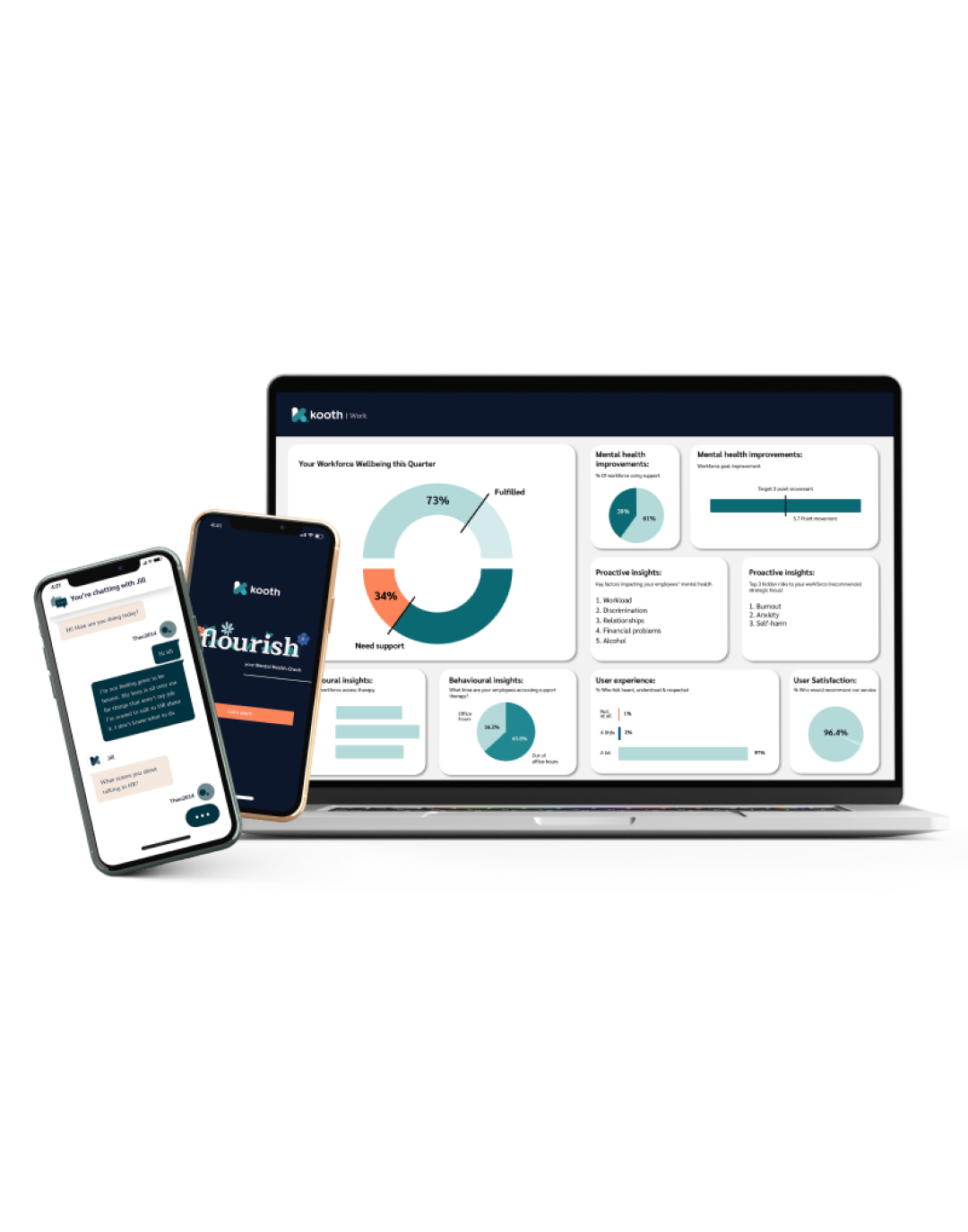Why prevention pays, and how a Framework can help
We’re all much more switched on about workplace wellbeing these days, but often, employers embrace reactive measures that focus on just treating problems when they happen. What we actually need is a proactive approach to employee wellbeing and mental health that works for the people these strategies are intended to serve.
According to Kooth Work’s Flourish research, only 18% of UK employees think their workplace does enough to support mental wellbeing. Now, this could be because two in five employees don’t know what support is actually available to them, but whichever way you slice it, people aren’t having their needs met in the workplace. Although we’ve learned a lot about the importance of mental wellbeing during lockdown and the pandemic, these findings haven’t been implemented in an effective way.
Admittedly, over the last few years, more employers have come to understand that their teams need at least some level of workplace support, but many programmes focus on facilitating reactive support for employees which becomes relevant only when their need is urgent – usually in the form of reactive EAPs (Employee Assistance Programs), MHFAs (Mental Health First Aiders), telephone emergency support call centres and treatment services.
While these 'urgent response' measures certainly have their place, they’re not enough in isolation. But what if we looked at helping people before they get to a state of emergency, put measures in place to nurture employees before they reached burnout, and offered support to help manage day-to-day challenges before anxiety or depression set in? Things would surely be a lot better for employees and employers.
Let’s take a look at how these things can be implemented and why thinking beyond reactive mental wellbeing support can be one of the most cost-effective changes your organisation makes this year.
Thinking beyond reactive mental wellbeing support
Workforce mental wellbeing is entering a new era of consciousness, moving beyond EAPs, telephone support and MHFAs, and towards prevention strategies for all. But why does that matter? Isn’t it enough to simply treat problems as and when they arise?
Not if you want to safeguard your employees’ mental wellbeing and protect your business from attrition, mounting sickness absence, and a damaged reputation.
Once your employees are struggling, the damage has already been done. That’s not to say reactive measures aren’t necessary or impactful - for anyone battling burnout, mental health conditions, or challenges in their everyday lives, these measures are absolutely critical. But what it does mean is that your employees are already experiencing sub-optimal wellbeing when they access those services.
We believe that every employee can thrive when the right support measures are in place - measures that tackle the root cause of poor mental wellbeing, offer a space for people to manage their own mental health, and build resilience for the future. While EAPs make expensive and specialist mental health treatment available for employees in urgent need, the gated nature of having to pass an assessment carries real limitations and complex barriers.
Instead, the most effective measures are the ones open to all - the accessible, inclusive support that prevents challenges from becoming, well, too challenging.

The Benefits of a prevention strategy for workplace wellbeing
Poor mental health is the number one reason for absenteeism in the UK and the main cause of long-term sickness in the workforce. With around 1 in 6 people (14.7%) experiencing mental health problems at work, it’s clear that preventing poor mental wellbeing can pay dividends for employers. Here are four benefits of a prevention strategy:
1. Increase ROI and effectiveness of support
A prevention and early intervention mental health strategy is five times more effective than following a treatment-based model.With one in five people developing an early diagnosable mental health condition every year, it’s not hard to see why. But as well as being better for your people, the return on investment of a preventative vs. reactive approach speaks for itself: according to Deloitte, investment in a universal (holistic) strategy is 1.65 times more cost-effective than focusing on reactive measures alone.
2. Achieve cultural change
Taking a proactive stance on mental wellbeing at work allows you to foster the kind of culture that prevents poor mental wellbeing from developing in the first place. And while you’re never going to be able to prevent the occurrence of mental illness, as some people are genetically predisposed to developing certain conditions, an open culture makes it easier for people to seek help, without fear of judgement.
3. Improve organisational performance
Kooth Work research found that work negatively impacts the mental health of one in three people, with 37% of employees showing moderate or high signs of burnout. 25% of the workforce have taken time off in the past year due to mental health, and one in four would consider changing jobs to a company with better mental health support.
When you evidence your commitment to employee wellbeing through preventative measures, their performance,and your business performance, improves. Employees begin to flourish at work, and you have less reason to worry about attrition or preventable sickness absence.
4. Reduce emergency incidents and reliance on costly reactive measures
Finally, a well-executed prevention strategy – one built on reporting, education, and early intervention – can lessen the number of employees needing to access reactive and emergency measures, helping you to save on costs.
Achieve more with less
Imagine the cost savings your organisation could make from a prevention approach. Consider the Flourish data. 37% of employees are at a medium to high risk of burnout, and nearly half showing signs of risk of depression. For an organisation with 2,000 staff, that is 740 people at risk of burnout and nearly 1,000 with a risk of depression.
Left unchecked the cost of the business from lost worker days, leavers and the treatment needed to get staff suffering from acute burnout and depression is costly at a financial and human level.
Placing 'prevention and early intervention' at the core of your organisation's wellbeing support plan can reduce the number of employees in your organisation ever getting to this stage.
Useful links
Kooth Work’s Flourish benchmarking tool
View the Checklist or download the mental wellbeing focused Framework Toolkit.
Read the partner article on how a Framework can help to improve mental wellbeing at work. Coming soon.






